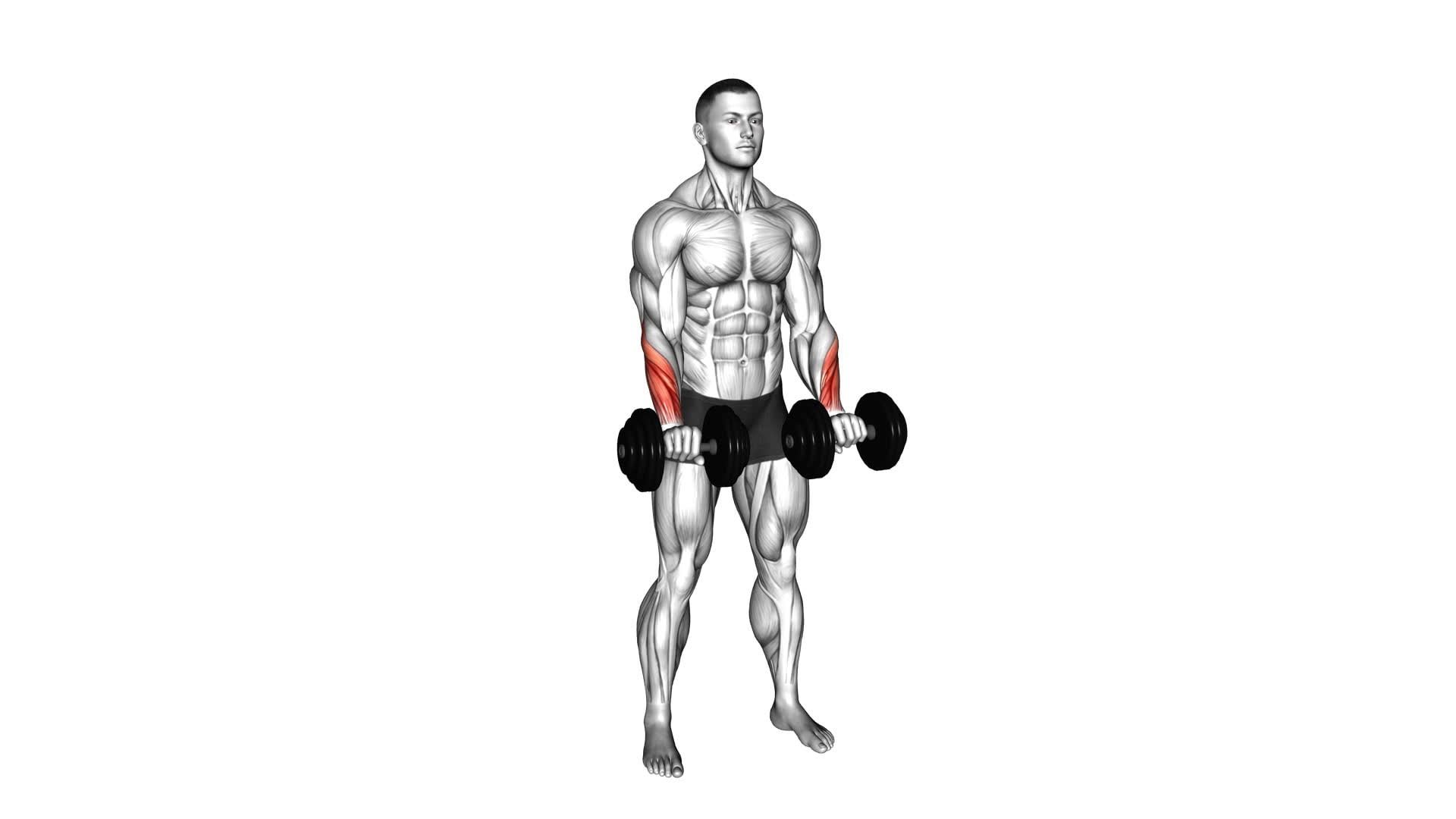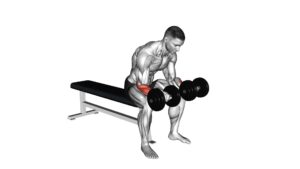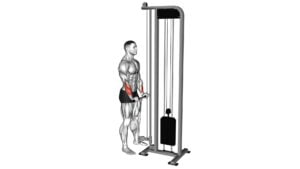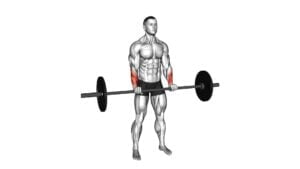Dumbbell Standing Wrist Reverse Curl – Video Exercise Guide & Tips

Are you looking to strengthen your wrists and forearms?
Watch This Exercise Video
In this article, you'll find a video exercise guide and expert tips for the Dumbbell Standing Wrist Reverse Curl.
Discover the proper form and technique, learn how to choose the right weight, and follow step-by-step instructions for execution.
Avoid common mistakes and find out how to increase difficulty for a more challenging workout.
Get ready to improve your wrist strength and enhance your overall fitness routine.
Key Takeaways
- Use a light to moderate weight dumbbell
- Start with a lighter weight if new to wrist strengthening exercises
- Keep elbows stationary and curl wrists upward towards the forearms
- Gradually increase weight as wrist strength improves
Proper Form and Technique
To perform the Dumbbell Standing Wrist Reverse Curl with proper form and technique, you should use a light to moderate weight dumbbell. This exercise is a great way to strengthen and tone your forearm muscles, improving grip strength and wrist stability. Standing exercises have numerous benefits, including engaging more muscles and promoting better balance and coordination.
To begin, stand with your feet shoulder-width apart and hold the dumbbell in an overhand grip, with your palms facing down. Keep your arms straight and close to your body throughout the exercise. Slowly curl your wrists upward, bringing the dumbbell towards your body, and then lower it back down to the starting position. Make sure to keep your elbows stationary and only move your wrists.
There are a few variations of wrist reverse curls that you can incorporate into your routine to target different areas of the forearm. One variation is the seated wrist reverse curl, where you sit on a bench or chair and perform the exercise with your forearms resting on your thighs. Another variation is the hammer curl, where you hold the dumbbell in a neutral grip, with your palms facing each other.
Remember to always start with a light weight and focus on maintaining proper form and technique. Gradually increase the weight as your strength improves. Incorporating the Dumbbell Standing Wrist Reverse Curl into your workout routine can help you develop stronger and more defined forearms while improving your overall upper body strength.
Choosing the Right Weight
When selecting the appropriate weight for the Dumbbell Standing Wrist Reverse Curl, consider your current strength level and choose a weight that challenges you without compromising proper form and technique. Here are some factors to keep in mind when choosing the right weight:
- Start with a lighter weight: If you're new to wrist strengthening exercises or have limited strength in your wrists, it's recommended to start with a lighter weight. This will allow you to focus on proper form and technique without straining your wrists.
- Gradually increase the weight: As your wrist strength improves, you can gradually increase the weight to continue challenging your muscles. This progression option will help you build strength and endurance over time.
- Listen to your body: Pay attention to how your wrists feel during the exercise. If you experience pain or discomfort, reduce the weight or modify the exercise until your wrists become stronger.
- Consult a professional: If you're unsure about the appropriate weight for your current strength level, it's always a good idea to consult a fitness professional or trainer. They can provide guidance and help you select the right weight for your wrist strengthening goals.
Choosing the right weight for the Dumbbell Standing Wrist Reverse Curl is essential for maximizing the benefits of wrist strengthening. By starting with a lighter weight, gradually increasing the weight, listening to your body, and seeking professional advice when needed, you can ensure a safe and effective workout.
Step-by-Step Execution
Start by holding a dumbbell in each hand with your palms facing down. Stand with your feet shoulder-width apart and maintain a slight bend in your knees. Keep your core engaged and your back straight throughout the exercise. This is your starting position.
To begin the exercise, exhale and slowly curl your wrists upward, bringing the dumbbells towards your forearms. Keep your elbows stationary and only move your wrists. Hold the contraction for a moment, squeezing your forearms, and then inhale as you slowly lower the dumbbells back to the starting position.
Repeat this movement for the desired number of repetitions. Remember to maintain control and avoid using momentum to lift the weights.
The dumbbell standing wrist reverse curl primarily targets the muscles in your forearms, including the wrist extensors. This exercise helps to strengthen and tone your forearms, improving grip strength and overall arm stability.
To progress this exercise, you can increase the weight of the dumbbells or perform the exercise on an unstable surface, such as a balance board or stability ball. This adds an additional challenge to your forearms and engages your core muscles for stability.
Variations of the dumbbell standing wrist reverse curl include using a barbell instead of dumbbells, performing the exercise one arm at a time, or using a resistance band. These variations target the same muscles but may offer a different level of difficulty and range of motion.
Common Mistakes to Avoid
One common mistake to avoid when performing the dumbbell standing wrist reverse curl is allowing your elbows to move during the exercise. This can compromise the proper execution of the exercise and reduce its effectiveness.
To ensure you're performing the exercise correctly and maximizing its benefits, here are four common mistakes to avoid:
- Allowing your elbows to move: Keep your elbows stationary throughout the exercise. This will isolate the muscles in your forearms and wrists, allowing them to work more effectively.
- Using excessive weight: It's important to start with a weight that you can comfortably lift and control. Using too much weight can lead to improper form and increase the risk of injury.
- Relying on momentum: Avoid using momentum to lift the dumbbells. Instead, focus on controlling the movement and engaging the muscles in your wrists and forearms.
- Neglecting proper form: Maintain proper form throughout the exercise. Keep your back straight, core engaged, and wrists in a neutral position. This will help target the intended muscles and prevent strain on other areas of your body.
Tips for Increasing Difficulty
To increase the difficulty of the dumbbell standing wrist reverse curl, you can incorporate progressive overload by gradually increasing the weight you lift. This progression technique is essential for challenging your muscles and promoting growth.
Start with a weight that allows you to perform the exercise with proper form and control. As you become comfortable with the movement, gradually increase the weight in small increments. This will ensure that your muscles are continuously challenged and adapting to the increased load.
In addition to progressive overload, you can also try variations and modifications to increase the difficulty of the exercise. For instance, you can perform the exercise on an unstable surface, such as a balance board or Bosu ball, to engage more stabilizer muscles.
Another variation is to perform the exercise with a single arm instead of both arms simultaneously. This places more emphasis on the working arm and increases the demand on your wrist flexors.
When incorporating variations and modifications, it's important to listen to your body and progress at a pace that's suitable for your fitness level. Don't rush into advanced variations if you aren't ready, as this can increase the risk of injury. Gradually introduce new challenges and monitor your progress to ensure steady improvement.
Frequently Asked Questions
How Many Repetitions Should I Do for the Dumbbell Standing Wrist Reverse Curl Exercise?
To determine how many repetitions you should do for the dumbbell standing wrist reverse curl exercise, it's important to consider your fitness goals and current strength level. Start with a weight that challenges you but allows you to maintain proper form.
Aim for 8 to 12 repetitions per set, performing 2 to 3 sets in total. This exercise targets the forearm muscles, improving grip strength and wrist stability.
Consistency and gradual progression will maximize the benefits of this exercise.
Can I Perform the Dumbbell Standing Wrist Reverse Curl Exercise Using a Barbell Instead of Dumbbells?
Yes, you can perform the dumbbell standing wrist reverse curl exercise using a barbell instead of dumbbells. Using a barbell for this exercise can provide some additional benefits.
Barbells allow for a greater range of motion and can help to strengthen your grip and forearm muscles even more. However, it's important to start with a lighter weight and focus on maintaining proper form to avoid any injuries.
Is It Necessary to Warm up Before Doing the Dumbbell Standing Wrist Reverse Curl Exercise?
Before performing any exercise, including the dumbbell standing wrist reverse curl, it's important to warm up. Warming up helps increase blood flow to your muscles, making them more flexible and less prone to injury.
It also prepares your body for the upcoming workout by increasing your heart rate and activating your nervous system.
Can I Incorporate the Dumbbell Standing Wrist Reverse Curl Exercise Into My Bicep Workout Routine?
Incorporating dumbbell standing wrist reverse curls into your bicep workout routine can be effective for targeting the forearms and improving grip strength.
This exercise specifically targets the muscles in your wrists and forearms, which can help with overall arm strength and stability.
Are There Any Alternative Exercises That Target the Same Muscles as the Dumbbell Standing Wrist Reverse Curl?
Looking for alternative exercises that target the same muscles as the dumbbell standing wrist reverse curl?
There are a few options you can try.
One option is the barbell wrist curl, which focuses on the same muscles but with a different grip.
Another alternative is the hammer curl, which targets both the biceps and the forearms.
Lastly, you could try the cable reverse curl, which provides a similar movement pattern to the dumbbell standing wrist reverse curl.
Conclusion
To effectively perform the dumbbell standing wrist reverse curl, it's important to maintain proper form and choose the appropriate weight. Following the step-by-step execution guide and avoiding common mistakes will help maximize the benefits of this exercise.
If you're looking to increase the difficulty, try incorporating some helpful tips. By following these guidelines, you can improve your wrist strength and enhance your overall fitness routine.

Author
Years ago, the spark of my life’s passion ignited in my mind the moment I stepped into the local gym for the first time. The inaugural bead of perspiration, the initial endeavor, the very first surge of endorphins, and a sense of pride that washed over me post-workout marked the beginning of my deep-seated interest in strength sports, fitness, and sports nutrition. This very curiosity blossomed rapidly into a profound fascination, propelling me to earn a Master’s degree in Physical Education from the Academy of Physical Education in Krakow, followed by a Sports Manager diploma from the Jagiellonian University. My journey of growth led me to gain more specialized qualifications, such as being a certified personal trainer with a focus on sports dietetics, a lifeguard, and an instructor for wellness and corrective gymnastics. Theoretical knowledge paired seamlessly with practical experience, reinforcing my belief that the transformation of individuals under my guidance was also a reflection of my personal growth. This belief holds true even today. Each day, I strive to push the boundaries and explore new realms. These realms gently elevate me to greater heights. The unique combination of passion for my field and the continuous quest for growth fuels my drive to break new ground.







